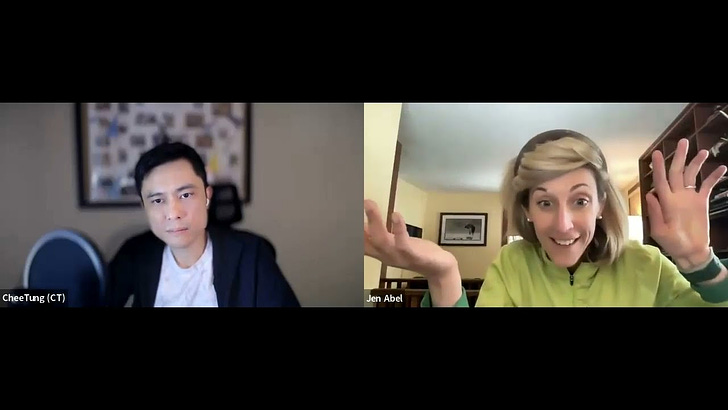"The Founder is not supposed to be a risk taker. The Founder's job is actually to systemically eliminate risk."
OK I lied.
The steps weren’t easy.
But Vinod certainly made them look easy.
In an era where startups sprout every day but few survive, breaking into a market like Silicon Valley from Asia can be nothing short of a Herculean feat.
That's why we had to sit down with Vinod Muthukrishnan, a man who’s been through the gauntlet and came out successfully on the other side.
We dug deep into the essentials for startups—particularly those from Asia—that want to make it big in the world's startup capital.
The Meet: Who is Vinod?
Meet Vinod Muthukrishnan, the former CEO and Co-founder of Cloudcherry, a SaaS startup that didn’t just survive but thrived, eventually being acquired by tech giant Cisco. With a rich track record that extends across multiple industries and borders, Vinod knows a thing or two about building and scaling startups.
He joined Cisco in 2019 after the successful acquisition. Vinod took Cloudcherry from Asia to the US in 2016 in a bold move to address a competitive and deep market, and we’re proud to capture some of his key insights here.
So you can imagine it was mildly disconcerting for me that I might end up going there and end up not getting any customers or getting any further traction, except that my cost to the company just increased dramatically between India and the US.
Prior to CloudCherry, Vinod had a diverse career that spanned from sailing as a First Officer in the merchant navy for nine years, to running global sales at a financial technology company. Vinod is also an avid reader, cricket fan and speaker who shares his insights on customer experience, leadership and entrepreneurship at various events and platforms including the influential SaaSBOOMi community.
Step 1: Why Silicon Valley?
The Challenge
Silicon Valley is like the Olympics for startups—everyone wants in, but what makes it so irresistible?
In (Vinod’s) two words: talent and opportunity. Silicon Valley is a talent magnet, pulling in the best and brightest from around the globe. Add to that the sheer volume of financial capital looking for the next big thing, and you’ve got a recipe for explosive growth.
‘nuff said.
"If you really want to meet great people, be open to great opportunities, hire incredible people, and just have the magic of serendipity happen to you, you want to go where network density is highest."
Step 2: Localization & Team Building
The Challenge
Getting your foot in the door is one thing, but how do you truly establish yourself in a new market?
Vinod insists that one of the first things to nail down when making this transcontinental jump is aligning the culture between your Asian and U.S. teams.
Cultural alignment isn’t just about team lunches or casual Fridays. It's about creating a unified vision and language that both teams can rally around.
The way work is done in Asia can differ considerably from the U.S. — from communication styles to decision-making processes. Vinod stresses that it’s vital to proactively address these differences to create a seamless operation.
💡Practical Application
Don’t wait for culture clashes to happen. Have open dialogue between teams, maybe even cultural training sessions, and invest in leadership that can smoothly bridge both worlds. This will not only prevent miscommunication but can also be a catalyst for innovative ideas born from the intersection of diverse cultures.
Step 3: Hustling for your first customer
The Challenge
So you've made it to U.S. soil with a fantastic product. Now comes the next hurdle: acquiring that all-important first customer. Hustle too hard, and you risk coming across as overly aggressive, which isn't a great look when nobody knows you yet.
Vinod emphasizes that in the early stages, you must balance hustle with credible delivery. Don't just promise the moon to get your foot in the door, especially when you're not yet a known entity.
Instead, aim to under-promise and over-deliver. This strategy could turn your first customer into a champion for your brand, something invaluable that no amount of marketing dollars can buy.
💡Practical Application
Your first customer acquisition should be a calculated, well-executed campaign. It's not about sending generic LinkedIn requests or blasting the same email to a list of prospects.
Customization is key.
Craft your pitch so that it solves a specific problem for a specific client, making them feel like your product was designed just for them.
In the early stage, quality trumps quantity. Dedicate the time to make each outreach as tailored and irresistible as possible.
"So early customers, you gotta hustle, you do it through network, you cold call people, you cold prospect someone."
Step 4: Balancing Resources Between Asia and the U.S.
The Challenge
It's not just a matter of 'copy-paste' from Asia to the U.S.; you have to consider how to allocate resources like talent, time, and capital in a way that makes sense for each market.
Vinod stressed the importance of being physically present in both markets. He says you can't remote control your operations, especially in the U.S. where establishing a local presence is often crucial.
The challenge is how to harmonize these operations without losing the core culture of your startup. Vinod's advice is to commit to the new market and build a team there, but don't forget your roots.
“You'd be amazed how unsettling that is. Just your regular operations…You have this window in the morning, you have a window in the night where all your calls, all your meetings have to come through.”
💡Practical Application
Hiring Locally: If the U.S. is a key market, you'll need a team on the ground. But choose wisely. The hires should not only be skilled but also culturally compatible with your Asian team.
Regular Check-Ins: Establish a robust internal communication rhythm. Maybe it's a bi-weekly all-hands meeting or regular video check-ins between teams. The goal is to foster a unified culture.
Financial Planning: Allocate resources with a keen eye on your ROI. It’s easy to burn through capital in the U.S., so keep tabs on your expenditures. Utilize analytics and data-driven methods to make your decisions more concrete.
Customer Support: Given the time zone differences, consider how to offer round-the-clock support without burning out your team.
Skill Transfer: There’s value in cross-pollination. Periodically rotate members between the teams in Asia and the U.S. for knowledge transfer and cultural integration.
Step 5: Amp up that networking
The Challenge
Breaking into a new market like the U.S. requires more than just a great product; you need connections to open doors. The network effect isn’t just a concept for your product; it’s vital for your personal growth as a founder too.
Vinod pointed out the inefficiency of a scattershot approach, like randomly reaching out to industry leaders on LinkedIn. According to him, the key to effective networking lies in the precision of your outreach.
You need to convey value, curiosity, and make it a two-way street. Your outreach needs to make the other person feel like "Hey, this is written for me."
💡Practical Application
Personalize Outreach: Do your homework. Know who you're reaching out to and tailor your message. Trust me, they’ll know if it's a copy-paste job.
Leverage Existing Networks: Use your alumni, accelerator, or even other startup founders in your diaspora to get warm introductions. They can add instant credibility.
Quality Over Quantity: It's better to have deep, meaningful relationships with a few key contacts than a long list of names you hardly know.
Events & Conferences: Don’t discount the value of face-to-face networking. Make it a point to attend relevant industry events, but have a strategy going in—know who you want to meet and what you want to accomplish.
Follow Up: The magic often happens in the follow-up. Keep the conversation going by providing updates on mutual interests, sharing valuable content, or simply checking in.
Use Tools and Analytics: Given your love for data, consider using networking tools that provide analytics. They can show you how effective your networking efforts are and where to improve.
The Send-off
Vinod Muthukrishnan’s journey from co-founding Cloudcherry to its acquisition by Cisco is a testament to his profound insights into startup success. Our conversation with him was peppered with actionable advice and grounded perspectives.
Vinod's experience with Cloudcherry serves as an inspiration and a guide for entrepreneurs looking to make their mark in the US tech ecosystem. By embracing the themes discussed in this article, Asian founders can hopefully pave the way for the next generation of cross-border unicorns.
If you have more questions, don't hesitate to drop them in the comments below!
This Substack is where I write about our experience expanding from a stable, growing market in Asia, to competing in the largest SaaS market in the world.
We’d like to invite you to join us on this adventure by subscribing:
Thanks for reading Silicon Jungle Chronicles! Subscribe for free to receive new posts and support our journey.
What to expect?
📊 Comparative Data Analysis: Deep dives into metrics and strategies, comparing and contrasting SaaS practices between East and West.
🎙 Podcasts: Candid chats with industry leaders, unveiling the challenges and triumphs of the startup journey.
🎤 Exclusive Interviews: Conversations with SaaS pioneers and innovators, sharing their unique insights and visions.
✍️ Opinion Pieces: My take on trends, disruptions, and the future of tech in these dynamic regions.
Who's this for?
• Founders seeking strategies and stories from dual perspectives.
• Investors eager for a fresh, grounded take on the evolving SaaS landscape.
• Tech enthusiasts, analysts, or anyone curious about the heartbeat of startup ecosystems in both the East and West.
Thanks for reading and do share with someone you think could benefit from it!













Share this post